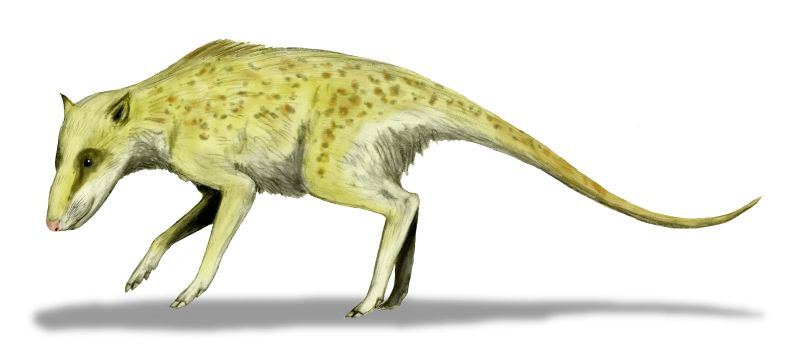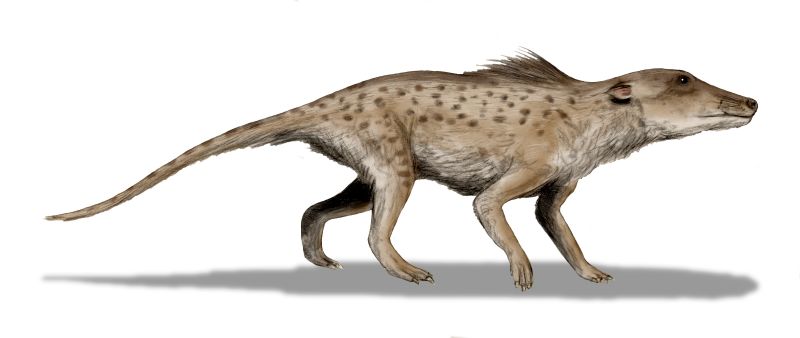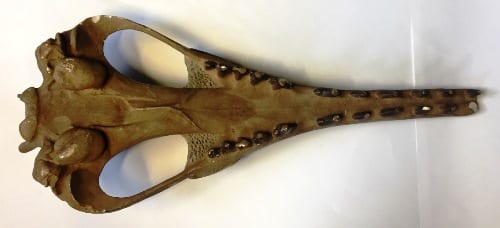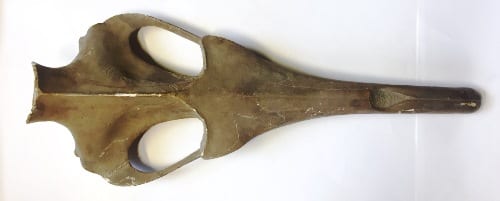Specimen of the Week 281: The Ancient Whale Skull
By zcqsrti, on 3 March 2017
The evolution of whales is truly a strange story, and relatively little was known about their ancestry until the early 1990s when palaeontologists unearthed a series of fossils from the Eocene of India and Pakistan that shed light on the transition of the group from water to land.
This painted model specimen of a mammalian skull has gone unidentified, until the past week when it has been recognised as none other than Protocetus atavus, from an identical specimen at the Museum für Naturkunde in Berlin. The first and foremost recognisable feature of this skull is it’s strangely long and streamlined shape, which appears to be what might happen if you gave a crocodile good ironing. Protocetus atavus is an early whale, and its name is steeped in origins; ‘Proto’ for original, ‘atavus’ for forefather, and ‘cetus’ after the Ancient Greek kētos (κῆτος), a name given to the vast sea monsters of mythology slain by Perseus and Heracles, and that which later denotes the term ‘cetacean’ (the mammalian order comprising whales and dolphins). Living in the middle Eocene of Egypt approximately 45 million years ago, this species is like a somewhat uncanny valley allegory for modern whales, retaining all four limbs with webbed fingers and toes, instead of flippers, and a mean set of widely spaced meat-shearing tricuspid premolars.

Protocetus by Nobu Tamura via Wikimedia Commons. CC-BY-3.0
All aboard the whale train
The earliest of all whales are known to have been artiodactyls, or even-toed hoofed mammals (like pigs and camels, but their closest living relatives are hippos), and were probably most similar in appearance to what we might call small deer. Slowly during their evolutionary descent into the water, cetaceans developed aquatic affinities as forelimbs reduced into flippers used mainly for steering instead of support; the hindlimbs themselves almost entirely atrophied into a vestigial bonemass found around the once pelvic region. The vertebral column fused and became more rigid at the front to aid swimming through the thicker medium of water, and nostrils slowly moved backwards along the snout until in modern species it faces vertically as a blowhole (to help faster breathing, without lifting their snout from the water while resurfacing). Somewhere along the lines they were able to function effectively in both worlds, and were able to rise from the water and walk on all fours. In fact, the otter-like species Pakicetus is thought to have been adapted to stalking in shallow waters, just below the surface, while its eyes remain exposed to spot and track unsuspecting prey (Thewissen, 2009). Even earlier cetacean species like the mostly terrestrial deer-like Indohyus had already started down the rather drastic path of osteosclerosis, or the hardening of bone, used to decrease buoyancy and aid hiding in the shallows.

Indohyus by Nobu Tamura via Wikimedia Commons. CC-BY-3.0

Pakicetus by Nobu Tamura via Wikimedia Commons. CC-BY-3.0
Thalassophobia and the Teenage Angst of Intermediate Whales
Early whales for some reason play up with my thalassophobic mind, in a really exciting way. Thalassophobia is the fear of deep sea, and more specifically, the fear of something unseen stirring between the spreading fingers of light, searching downwards into the murky depths. The idea of someone slowly stalking on the cusp of emerging from the water’s surface, who is easily equipped to continue a pursuit onto dry land especially terrifies me, not to mention when it might look as bizarre as an early whale; a balding, bone hardened, shambling mass (but not as far back as Indohyus, mind, they’re quite cute). Strangely enough, the slight unease I feel when thinking about some intermediate whales is the same unease I felt as a small child when first faced with the front covers of the ‘Animorphs’ books. A Scholastic science fantasy book series from the late nineties, Animorphs featured shape-changing humans able to take on the form of certain animals, such as tigers, cobras and even a starfish. The front covers of which always showed a step by step transformation between the two, featuring a series of intermediates that always had a horrible CGI uncanny valley feel to them. I’d imagine if the deer-like creatures of the Indian Eocene had grasped a pen in their cloven hooves and written a science fantasy series about shapeshifting teenagers, and the angst and subsequent body dismorphia that comes with it, it might have looked a bit like the evolutionary path of the average modern-day cetacean.
Rowan Tinker is the Museum Intern at the Grant Museum of Zoology, UCL
References
Thewissen, J. G. M.; Cooper, Lisa Noelle; George, John C.; Bajpai, Sunil (2009). “From Land to Water: the Origin of Whales, Dolphins, and Porpoises” (PDF). Evolution: Education and Outreach. 2 (2): 272–288.
 Close
Close



